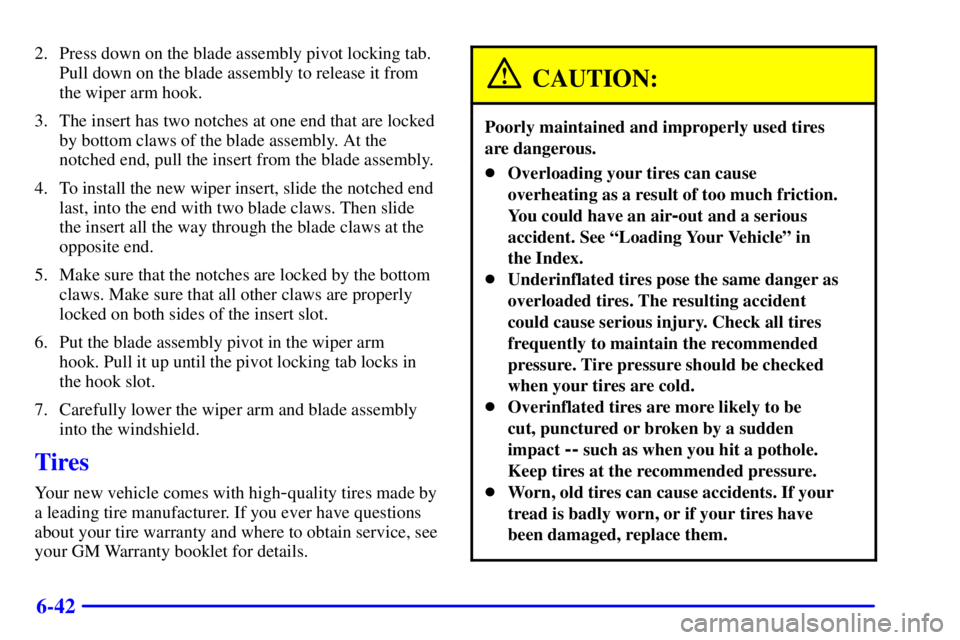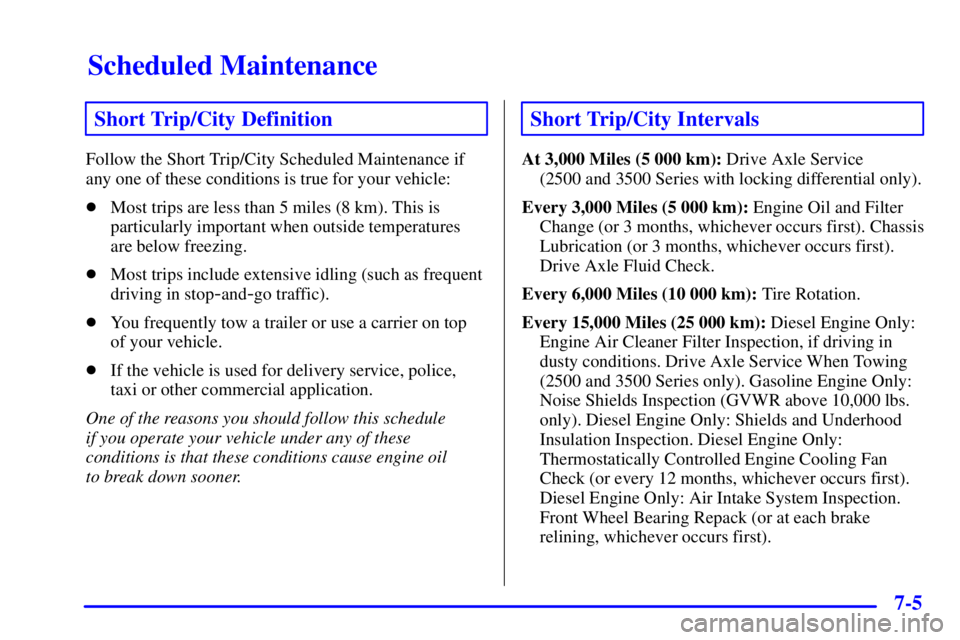Page 304 of 411
6-37
2. Remove the lamp from the grille.
3. Squeeze the tab on the side of the bulb assembly
while turning it counterclockwise.
4. Remove the bulb assembly from the back of the lens
and replace the bulb.
5. Turn the socket clockwise to reinstall it in the lens
assembly. Reinstall the screws on the parking/turn
signal lamp assembly.
Sidemarker Lamps
1. Remove the screw from the top of the lens.
Page 307 of 411
6-40
5. Lift the lamp as you
turn it toward the rear
of the vehicle.
6. To remove, squeeze the tab on the side of the sockets
while turning them counterclockwise.
Page 308 of 411
6-41
7. Turn the old bulb counterclockwise to remove it.
Install the new bulb.
8. Reverse the above steps to reinstall the lamp.
Windshield Wiper
Blade Replacement
Windshield wiper blades should be inspected at least
twice a year for wear and cracking. See ªWiper Blade
Checkº in the Index for more information.
Replacement blades come in different types and are
removed in different ways. To remove the type with a
release clip, do the following:
1. Lift the wiper arm until it locks into a
vertical position.
Page 309 of 411

6-42
2. Press down on the blade assembly pivot locking tab.
Pull down on the blade assembly to release it from
the wiper arm hook.
3. The insert has two notches at one end that are locked
by bottom claws of the blade assembly. At the
notched end, pull the insert from the blade assembly.
4. To install the new wiper insert, slide the notched end
last, into the end with two blade claws. Then slide
the insert all the way through the blade claws at the
opposite end.
5. Make sure that the notches are locked by the bottom
claws. Make sure that all other claws are properly
locked on both sides of the insert slot.
6. Put the blade assembly pivot in the wiper arm
hook. Pull it up until the pivot locking tab locks in
the hook slot.
7. Carefully lower the wiper arm and blade assembly
into the windshield.
Tires
Your new vehicle comes with high-quality tires made by
a leading tire manufacturer. If you ever have questions
about your tire warranty and where to obtain service, see
your GM Warranty booklet for details.
CAUTION:
Poorly maintained and improperly used tires
are dangerous.
�Overloading your tires can cause
overheating as a result of too much friction.
You could have an air
-out and a serious
accident. See ªLoading Your Vehicleº in
the Index.
�Underinflated tires pose the same danger as
overloaded tires. The resulting accident
could cause serious injury. Check all tires
frequently to maintain the recommended
pressure. Tire pressure should be checked
when your tires are cold.
�Overinflated tires are more likely to be
cut, punctured or broken by a sudden
impact
-- such as when you hit a pothole.
Keep tires at the recommended pressure.
�Worn, old tires can cause accidents. If your
tread is badly worn, or if your tires have
been damaged, replace them.
Page 330 of 411
6-63 Instrument Panel Fuse Block
The fuse block access door
is on the instrument panel
above the hood release
lever on the driver's side
of the vehicle.
You can remove the cover by turning the
fastener counterclockwise.
You can remove fuses with a fuse extractor. The fuse
extractor is mounted to the fuse block access door.
To remove fuses if you don't have a fuse extractor, hold
the end of the fuse between your thumb and index finger
and pull straight out.Be sure to use the correct fuse. If you ever have a
problem on the road and don't have a spare fuse, you
can borrow one of the same fuse rating. Just pick
some feature of your vehicle that you can get along
without
-- like the radio or cigarette lighter -- and
use its fuse, if it is of the same fuse rating you need.
Replace it as soon as you can.
Page 332 of 411
6-65
POSITION NAME CIRCUITS PROTECTED
14. ILLUM Instrument Panel Cluster, HVAC Controls, RR HVAC Controls,
Instrument Panel Switches, Radio Illumination,
Door Switch Illumination
15. DRL Daytime Running Lamp Relay
16. TURN B/U
Front Turn, RR Turn, Back
-up Lamps, BTSI Solenoid
17.
RADIO
-1Radio (Ign, Accy), Upfitter Provision Relay
18. BRAKE 4WAL PCM, ABS, Cruise Control
19.
RADIO
-BRadio (Battery), Power Antenna
20. TRANS PRNDL, Automatic Transmission
21. SECURITY Passlock
22. RR DEFOG Rear Window Defog
23. NOT USED Not Used
24. RR HVAC RR HVAC Controls, HIGH, MED, LOW Relays
A. PWR ACCY
Power Door Lock, Six
-Way Power Seat, Keyless Entry
Illumination Module
B. PWR WDO Power Windows
Page 333 of 411
6-66 Engine Compartment Fuse Block
The fuse block is in the engine compartment on the
driver's side of the vehicle.
NAME CIRCUITS PROTECTED
SPARE Spare Fuse
A.I.R. Air Pump
BLOWER Front Blower Motor
ABS Electronic Brake Control Module
IGN B Ignition Switch
IGN A Starter Relay, Ignition Switch
BATT Instrument Panel Fuse Block
LIGHTING Instrument Panel Fuse Block,
Headlamp Switch
RH
-HDLP Right-hand Headlamp
(Export only)
LH
-HDLP Left-hand Headlamp
(Export only)
RH
-HIBM Right-hand High-beam Headlamp
(Export only)
LH
-HIBM Left-hand High-beam Headlamp
(Export only)
Page 344 of 411

Scheduled Maintenance
7-5
Short Trip/City Definition
Follow the Short Trip/City Scheduled Maintenance if
any one of these conditions is true for your vehicle:
�Most trips are less than 5 miles (8 km). This is
particularly important when outside temperatures
are below freezing.
�Most trips include extensive idling (such as frequent
driving in stop
-and-go traffic).
�You frequently tow a trailer or use a carrier on top
of your vehicle.
�If the vehicle is used for delivery service, police,
taxi or other commercial application.
One of the reasons you should follow this schedule
if you operate your vehicle under any of these
conditions is that these conditions cause engine oil
to break down sooner.
Short Trip/City Intervals
At 3,000 Miles (5 000 km): Drive Axle Service
(2500 and 3500 Series with locking differential only).
Every 3,000 Miles (5 000 km): Engine Oil and Filter
Change (or 3 months, whichever occurs first). Chassis
Lubrication (or 3 months, whichever occurs first).
Drive Axle Fluid Check.
Every 6,000 Miles (10 000 km): Tire Rotation.
Every 15,000 Miles (25 000 km): Diesel Engine Only:
Engine Air Cleaner Filter Inspection, if driving in
dusty conditions. Drive Axle Service When Towing
(2500 and 3500 Series only). Gasoline Engine Only:
Noise Shields Inspection (GVWR above 10,000 lbs.
only). Diesel Engine Only: Shields and Underhood
Insulation Inspection. Diesel Engine Only:
Thermostatically Controlled Engine Cooling Fan
Check (or every 12 months, whichever occurs first).
Diesel Engine Only: Air Intake System Inspection.
Front Wheel Bearing Repack (or at each brake
relining, whichever occurs first).